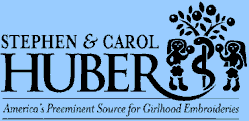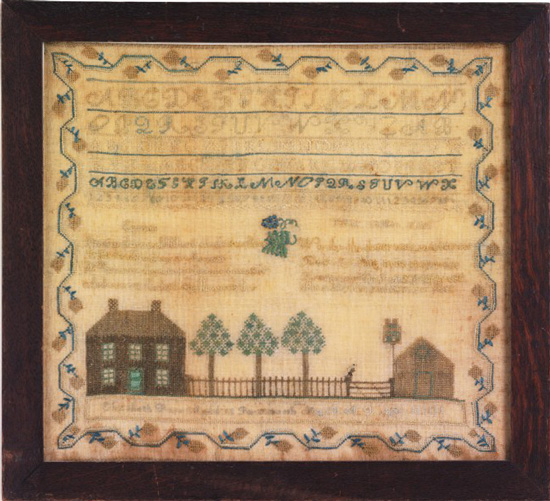|
|
|
|
Lot Number: 281-1(description taken from Sotheby's catalogue)
Sothby's estimate: $8,750- $12,500 (for lot, 281-1 and 281-2 combined with 25% buyer's premium added) Sold (SPECIAL SALES PRICE - no
buyers premium) (To purchase call 860-388-6809)
Catalogue Note: In 1773, David McClure, a Portsmouth, New Hampshire, schoolmaster, wrote: "Opened school, consisting the first day of about 30 Misses. Afterward they increased to 70 or 80; so that I was obliged to divide the day between them and one half came in the forenoon and the other in the afternoon. They were from 7 to 20 years of age. I attended to them in reading, writing and arithmetic and geography principally. This is, I believe, the only female school (supported by the town) in New England, and is a wise and useful institution."1 By the first quarter of the nineteenth century schools for girls in Portsmouth were well established and instruction in needlework and its various branches was diligently pursued. The stylistic format of Elizabeth Dore's sampler-with its distinctive birdhouse and pyramid-shaped trees-was employed in this New Hampshire town as early as 1810, when Deborah Laighton embroidered her sampler with the name of her schoolmistress, Mary Ann Smith.2 Many of the samplers worked in this format, such as that stitched in 1818 by Priscilla Hall Badger at Elizabeth S. Smith's school, were worked on a green linsey-woolsey fabric instead of the more common plain-weave linen.3 Particular to this group is the inclusion of the month, day, and year that the sampler was embroidered. The popularity of this pattern continued at least until 1835 when Martha Jane Fowler4 stitched her sampler; the names of at least four schoolmistresses are inscribed on samplers of this style. For example, those worked between the years 1810 and 1822 name Mary Walden, E. Walden, Elizabeth S., and Mary Ann Smith. One would suspect that the two Smiths and two Waldens were related, although such evidence has yet to be confirmed.5 We may assume, however, that the two kindred samplers embellished with arcaded strawberry borders-the first worked by Elizabeth Dore, and the second by Adaline M. Ferguson, who named E. Walden as her schoolmistress-are products of the same classroom in 1822.6 Samplers worked in the characteristic Portsmouth tradition with the understanding that students at other schools in this seaport town may have stitched samplers of a different sort-always gave prominence to a federal-style house, often in perspective. A picket fence forms a band of ribbing across the sampler, attaching house to barn. One bird is usually resting on the gatepost, and the birdhouse (with its own chimney) is on a tall pole high above the roofline of the barn. Another identifying feature is the depiction of trees: they are invariably arranged in odd numbers of one, three, or five, depending on the width of the sampler, and embroidered in a circular arrangement of cross-stitches. They shade the farmyard between the house and the barn.7 When reviewing this exceptional body of schoolgirl embroidery it becomes evident that, as with other embroidery patterns, this pleasing sampler style became a needlework tradition in Portsmouth, accepted by schoolmistresses and fashionable folk alike, for a period of at least thirty years, from 1810 to 1840.8 Although the Dore family is recorded as early as 1675 in Portsmouth Harbor, once called Strawbery Banke, the census of 1810 places John Dore and John Dore, Jr., in Somersworth, Strafford County, New Hampshire.9 Elizabeth was born in 1809, to John Dore, Jr., and his wife, Elizabeth. The Portsmouth City Directory for 1821 reveals John Dore, a farmer, was living on Ham's Street, which ran from North Street to the Creek. Elizabeth Dore married Ezekiel Dyer, mariner, in 1829.10 Ezekiel died at twenty-five in 1832. By 1834, Eliza Dyer, laundress, was living in a house at 20 Bridge Street with her widowed mother, Betsey, and her only child, Ezekiel.11 Eliza Dore Dyer died on March 17, 1864, at the age of fiftyfive.12 1. Woody, History of Women 's Education, vol. 1: 144. 2. The Laighton sampler is in a private collection; see Sotheby's, New York, catalogue, The Theodore H. Kapnek Collection of American Samplers, 4531 Y, January 31,1981, lot 67. 3. The Badger sampler is in a private collection; see Krueger, New England Samplers, 36. 4. The Fowler sampler is in the collection of Mr. and Mrs. Kent Willis; see Sotheby's, 4531Y, January 31,1981, lot 147. 5. Mary Walden's name is inscribed on the sampler worked by Caroline Vaughan, 1818 (location unknown; see Krueger, New England Samplers, 37). Elizabeth S. Smith was Priscilla Hall Badger's schoolmistress during the same year (ibid., 36). 6. E. Walden's School is named on the 1822 sampler worked by Adaline M. Ferguson (collection, Betty Ring); see Ring, American Needlework Treasures, 19. 7. For another example, see the sampler worked by Martha Jane Fowler, 1822, Sotheby's, 4531Y, January 31,1981, lot 147. 8. Ibid., lot 67. See also Ring, American Needlework Treasures, 19. Ring gives 1818 as the beginning date, but Deborah Laighton's identical sampler was worked in 1810. 9. Correspondence with John LaBranche, September- October 1982, formerly of Strawbery Banke, who so kindly shared his research on Elizabeth Dore with me. 10. Wentwarth Genealogy, 278. See also Portsmouth Journal and Rockingham Gazette, August 15, 1829. Researched by John LaBranche, to whom I am indebted. 11. Portsmouth City Register and Directory, 1834. Researched by John LaBranche. See also Portsmouth City Register and Directory, 1851. I wish to thank the librarians in the Portsmouth Public Library for their kindness in sharing various early publications with me. 12. Portsmouth Town Records, compo John Eldridge Frost, vol. 2: 27. My thanks to librarians at the Portsmouth Public Library. Provenance:
STEPHEN & CAROL HUBER |


